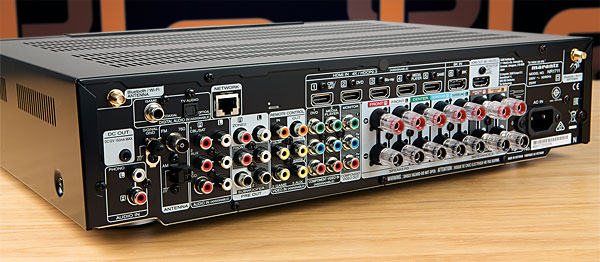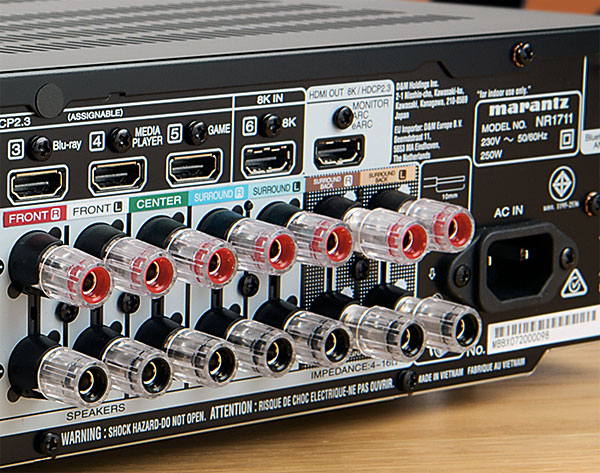Marantz NR1711 Seven-channel 8K-capable Dolby Atmos AV receiver review

 The affordable Marantz NR receiver could meet all your cinema and gaming needs, says Steve May
The affordable Marantz NR receiver could meet all your cinema and gaming needs, says Steve May
The latest in Marantz's now long-established slimline, half-height receiver range, the NR1711 is a bijou behemoth for those of us who don't require unhinged power, but do want advanced connectivity to best work with modern wired and wireless sources.
A stablemate to, but considerably better specified than, the 5.1-channel slimline NR1510 (there's no sign yet of an NR1511). this seven-channel model is perhaps more akin to the full-sized SR5015, just not as powerful (it's rated at 7 x 50W rather than 7 x 100W). And it sells for about £200 less.
Standing a shade over 10cm high, this slender AVR cuts a classic Marantz profile, with familiar curved fascia, twin dials and large display. A pull-down flap to hide its front-panel buttonry would make it even more slick, but you don't get one.
Connectivity is good for the price. All six HDMI inputs support Dolby Vision, HLG, eARC and HDR10+, as well as VRR, QFT, ALLM and QMS. It's like an explosion in an acronym factory.
The caveat is that only one input, helpfully labelled 8K, supports 4K/120 passthrough and 8K sources at 60fps. And there's still only one HDMI output.
As widely discussed late last year, next-gen consoles can present a blank screen when connected to a 4K/120-compatible TV input, via the aforementioned 8K input, with titles capable of running in 120fps. It's a situation Marantz acknowledges, and suggests a firmware solution to this industry-wide bug is being worked on.
An obvious workaround is to connect any offending PS5 of Xbox Series X directly to the display, and use eARC to feed audio back to the NR1711. Alternatively, leave the console and AVR in default 4K 60fps mode. Given this is largely the standard we're seeing from game developers anyway, it's a better solution until another option arrives.
There's another benefit from taking this 60fps approach, as it theoretically frees up the console to use more processing power for ray tracing and shadow detail, leading to superior image performance.

Wireless Wonder
The NR1711 isn't short of toys. Built-in HEOS is handy for multiroom playback with other HEOS speakers, while Apple AirPlay 2 serves much the same purpose. In addition to 2.4GHz/5GHz Wi-Fi, there's Bluetooth, useful not just for streaming podcasts from your mobile, but pairing wireless headphones for late-night/me-time listening. This expanded headphone functionality came to the NR1710 [see HCC #305] in an update after launch, but here's it's good to go straight from the box. Twin Wi-Fi/Bluetooth aerials screw left and right onto the back panel.

Object-oriented audio support covers Dolby Atmos and DTS:X. Of course not everyone has physical height speakers, so there's also Dolby Atmos Height Virtualization and DTS Virtual: X on hand to emulate a 3D listening experience, without the need for dedicated height speakers.

Both modes extrapolate height information to create an enveloping virtual effect. It works well if your physical layout is standard 5.1. The main theme for Okja (Netflix, Dolby Atmos), which plays over the end credits, becomes forest dense and lush. These modes shouldn't be confused with the Virtual Movie setting accessed via the remote, which is unrelated legacy processing that should be consigned to history.
Processing comes from a Cirrus Logic 32-bit Coyote DSP, with a 32-bit AKM AK4458 DAC on all channels. Hi-res-enabled, it'll work with ALAC, FLAC and WAV lossless files up to 24-bit/192-kHz, plus DSD 2.8MHz/5.6MHz tracks.
Room calibration is via Audyssey MultEQ XT. A new dual speaker preset allows you to switch settings on the fly, so you can run optimized configurations for different listening conditions.
 |
Home Cinema Choice #351 is on sale now, featuring: Samsung S95D flagship OLED TV; Ascendo loudspeakers; Pioneer VSA-LX805 AV receiver; UST projector roundup; 2024’s summer movies; Conan 4K; and more
|






















































